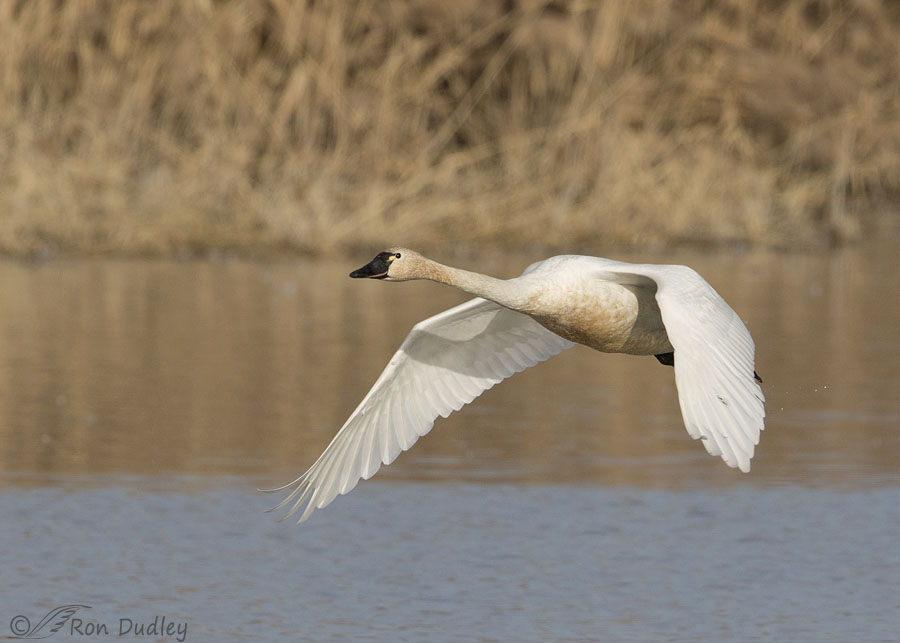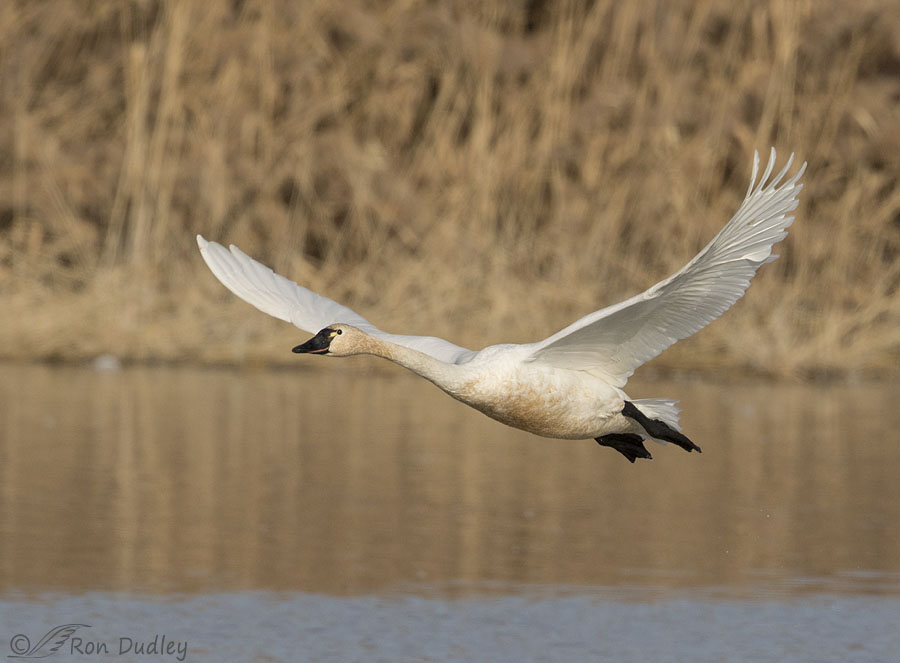A fairly brief post this morning after yesterday’s image marathon.
This is the time of year I usually see my first Tundra Swans of the season. I’ve heard at least one report of them having arrived at Bear River MBR but I’ve yet to see (or hear) any myself. These photos were taken last February at Bear River.

1/2500, f/9, ISO 500, Canon 7D Mark II, Canon EF 500mm f/4L IS II USM + EF 1.4 III Extender, not baited, set up or called in
On this morning I spent much of my time trying to photograph multiple swans as they landed or took off and I’ve posted several of those images in the past but this was a single bird in the frame as it was coming in to land on the water.

1/3200, f/9, ISO 500, Canon 7D Mark II, Canon EF 500mm f/4L IS II USM + EF 1.4 III Extender, not baited, set up or called in
This is the next shot in the burst. I really like the sweep of those huge wings although I do wish the bird wasn’t quite so centered in the frame (I had no more room on the left).
On this morning it was a treat to finally get some swans up close, close for swans at least. As usual for them for much of last winter they had been far out on the refuge where I could only see them as miniscule white dots on the water, when I could see them at all.
But man, can you ever hear them out there! Groups of swans calling on the water can be heard from a couple of miles away and it’s an eerie, haunting sound on a cold, crisp morning. If you’re interested that sound can be heard here (the first of the three sound files labeled “Flight Calls” in the link). If you listen to it you can hear swans passing by overhead and many others still on the water.
I suspect this swan and the others it was with were close to the auto tour road at the refuge because by then hunting season was over so they weren’t so spooky of vehicles and people.
Ron


Wow! Sensational shots Ron!
Charlotte
It was delightful to see and hear these magnificent creatures!
Ron, beautiful photos of a swan in a landing pattern that is surreal and serene. What a beautiful bird.
Hope you are feeling better. It is such a challenge for me, and I assume you, to climb over that big hurdle of physical challenges.
You always present such a great photographic treat for me.
Thanks, Alice
Thank you, Alice. I do have some better days.
Wonderful shots. I love the elegant birds. Here in the high desert we don’t see them. Further north of us, and along the coast the non-breeding birds reside. You made me smile Ron!
Glad to hear it, Jean. Thanks.
Nice images. The face helps me to remember the difference between the Tundra and Trumpeter.
Thank you, Lyle.
Thank you so much for including the calls – though it messed with our cat’s mind. I on the other hand loved it.
And the image.
Such a majestic bird. They are hunted? Or are they just collateral damage? Hiss and spit either way.
I love messing with cats minds. Magpies are experts at it…
Yes, we sure do have a swan hunting season.
Not sure, but think that’s actually an angel….
Hi, Ron,
We did solve the commenting problem, but for some reason your blog just does not like my email address. I clicked both receive email to alert me on your return comments and future blog post alerts. I got neither today. Not in my inbox, not in my junk mail. I don’t know why this is happening, and I am not asking you to spend even one minute on it because I am now trained to just go to your blog each day. But it is curious. Most of the time I am trying to get off the email list of sites I care nothing about. I usually don’t have to work at getting ON a list. Oh well, back to birds (thankfully we have beautiful and fasinating birds). The tundra swans’ wing span is spectacular. And your comment about the ancient sound they create as a group reminds me of traveling to Nebraska, to the Platte, to view the Sandhill Crane migration. Their harsh calls could be heard everywhere. We would drive the back roads of the many farms with our car windows down and we could hear them long before we would spot them. Wonderful memory. Thanks! Cathryn
Yes, there’s some similarities between the far-off calls of large groups of both Sandhill Cranes and Tundra Swans. We solved half you’re problems – it could be worse…:)
Beautiful birds and beautiful photos. Thanks for sharing. Very rarely do we see them. About every three or four years a couple strays will land in one of our lakes and stay for a couple months.
Everett Sanborn, Prescott AZ
Thanks, Everett. We get lots of them in certain areas.
Gorgeous birds even if their breast/necks get less than “pristine” from the water and feeding activities! Haven’t heard any conversation about them coming through here – we do get Snow Geese in the spring. Thx for the tip on them and Canada Geese – VERY helpful information!
Haven’t heard any conversation about them coming through here – we do get Snow Geese in the spring. Thx for the tip on them and Canada Geese – VERY helpful information!
You’re welcome, Judy. I actually like those red/orange iron stains they get on their bellies and chests, if for no other reason than it provides a little more contrast for my focus points to lock onto…
Good point!
These are beautiful shots. I really like the spread of the wings in the second one. Your comment about them being less spooky of vehicles and people is fascinating. It has never occurred to me that birds or other animals would be aware of the end of hunting season.
It takes them a day or so to get “tuned up” when hunting season starts and a few to figure out when it ends. We see it mainly in the deer here but know duck/goose hunters note that it gets tougher later in the season. Great survival skills!
Yup, none of them are stupid, Judy.
There’s no question they’re aware, Susan. At Farmington the north end of Unit 1 is a “rest area” for waterfowl so there’s no hunting there. And usually there’s very few birds there but within a few days of hunting season starting up there are often many thousands of ducks on that unit seeking refuge. They learn and they learn quickly.
Gorgeous birds and photos. Thanks for the hint about calling before taking off! I don’t often see them, but if I seek them out it will give me a head start.
The biggest hurdle is usually getting close enough to them, Nancy. But once you’re there knowing that little trick really helps.
The grace that follows the “ugly duckling” phase is indeed evident in these shots, Ron. Hope you get to photograph this season’s swans soon.
I’m hoping so too. Marty. I just never know from year to year and that’s especially true this year because of the drought and all the crazy things the refuge has been doing with water recently.
Such an elegant bird. The contrast of white and black especially those black feet… ! I know what you mean about the sounds…haunting. I had the pleasure of sitting one evening last spring watching and hearing several hundred as they came in to the marsh. Listening to the greeting calls and the sounds of settling in for the night was beautiful over the water. It is one of those moments you never forget.
! I know what you mean about the sounds…haunting. I had the pleasure of sitting one evening last spring watching and hearing several hundred as they came in to the marsh. Listening to the greeting calls and the sounds of settling in for the night was beautiful over the water. It is one of those moments you never forget.
Kathy, as a bird photographer one of the things I appreciate about swans is that individual birds usually start calling just before they take off from the water (similar to the Canada Goose). That allows me to train my lens on the correct bird(s) just before they start running across the water. A distinct advantage for the photographer!
I did not realize that…I’ll have to watch for that. Thank you…
It’s something you can almost count on.